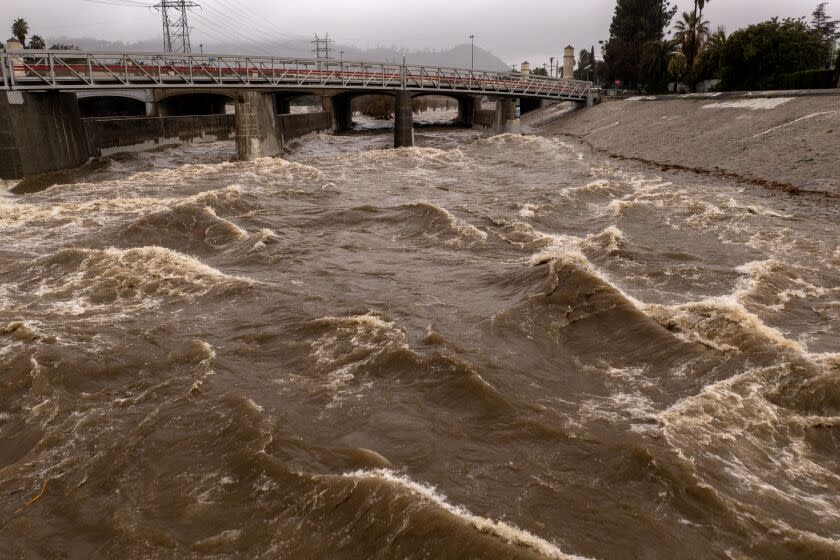Opinion: Water in Los Angeles -- it's complicated. Readers discuss what to do with it

In Los Angeles, we pray for rain most of the year. But only for a manageable amount in the winter months. And never after a big wildfire, when downpours can dislodge weakened hillsides and produce dangerous debris flows.
In other words, our relationship with water is complicated. The fickle rivers that long ago served as our primary water sources are now the concrete-lined channels shunting much of the atmospheric river torrent safely into the ocean. But when the rain stops and doesn't start again for months, we'll miss that water.
And so the debate over what Los Angeles should do with stormwater rages on, as it has in the past and will continue as climate change takes hold.
————
To the editor: California had a record budget surplus last year, but our outdated and inadequate rainwater storage situation remained largely unaddressed.
Our reservoirs are now filling, but there is not enough capacity to reflect the new reality of climate change and unreliable rainfall patterns each year. The "atmospheric river" dumping water on our state is not something for which we can reliably plan.
Without substantial new investments and commitments to capture, store and move water throughout the state, California communities will continue to be subject to water scarcity, and farmers will be unable to produce adequate food supplies.
Over the past 40 years, California has not completed a major water storage project of statewide significance. This failure to plan for drought conditions is forcing farmers to reduce acreage and take thousands of acres of land out of production. The land is sinking in many parts of the state, as wells are tapped and drilled farther to reach depleting supplies of fresh water.
We cannot simply conserve or recycle our way out of current and future droughts. More water storage and infrastructure are a fundamental part of the solution.
Ward Fredericks, Indian Wells
..
To the editor: Please remember the Tulare Lake in the San Joaquin Valley, which was drained by years of water theft.
This lake in the Central Valley was the largest fresh water lake west of the Mississippi River. The waters that fed it have been diverted.
Not surprisingly, subsidence has become an issue.
Robert Ross Brown Jr., Sun City, Ariz.
..
To the editor: I am completely committed to conserving water whenever possible. I keep a bucket in the shower and I pulled out my lawn.
But nothing irritates me more than driving over the L.A. River on my way to work during a storm and seeing billions of gallons of water rushing off to the ocean.
We live in a semi-arid climate. Can we be proactive and think about how to store that water?
Kathryn Smith, Pasadena
..
To the editor: Why is drought-weary Los Angeles letting most of this stormwater flow into the ocean? Because it cannot come up with new ways to harvest as much of this sorely needed water as possible.
Southern Californians are so locked into the "rain bad, sunshine good" mind-set that what should be the answer to a prayer is seen as an adversary.
Unfortunately, rain does not fall in tidy intervals into existing reservoirs and nowhere else. But something has to be done to make the most of the current rainfall windfall.
Kevin Dawson, Los Angeles
..
To the editor: Questions over why Los Angeles allows so much rainwater to flow into the ocean arise out of historical ignorance. They are naive in the face of hydrologic realities.
In the spring of 1825, a cataclysmic flood occurred along the L.A. River. The event was far worse than any other flood on record, and it took place when the watershed upstream of present-day downtown L.A. was all natural terrain.
Now, given existing development and the rise of climate change, we are only left to imagine what would occur across the flatlands of the Los Angeles Basin if such an event were to happen again. Doubtless, it would be the greatest disaster in the history of the United States.
John Crandell, Sacramento
..
To the editor: While Los Angeles County works toward completing its stormwater capture system, Angelenos can make choices that collectively will improve our water situation.
Each time we choose porous surfaces such as decomposed granite and bark paths over hardscapes like asphalt and concrete, we set up our own micro-systems for the capture of precious rainwater. In doing so, we also support local biodiversity.
Brad Rumble, Los Angeles
..
To the editor: Your op-ed article on how to conserve some of the continuing deluge is interesting, but it did not mention the state of our already existing underground water infrastructure.
In 2014, 2020 and just this past November, rotting water mains under UCLA burst and spewed tens of millions of gallons of water out onto the campus and the surrounding streets in Westwood. I guess that is to be expected when one is talking about pipes that are almost 100 years old.
Even when burst water mains are repaired, it's just a matter of time before others give elsewhere in the city. It's like living on a giant water balloon.
Any discussion about infiltration basins, dams or desalination is absurd when we can't even manage to keep what we already have.
Paula Del, Los Angeles
This story originally appeared in Los Angeles Times.

